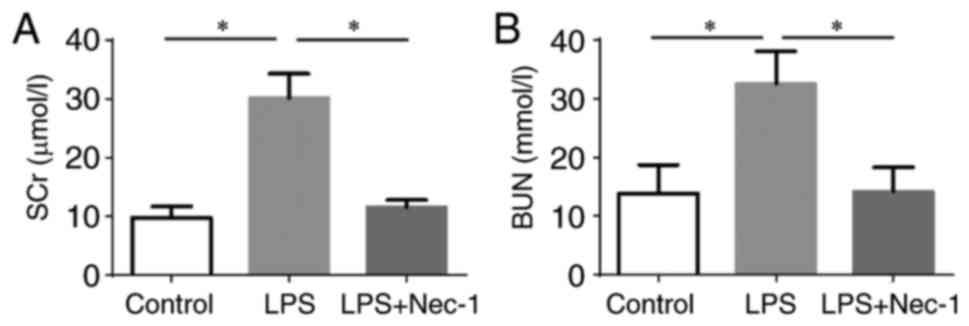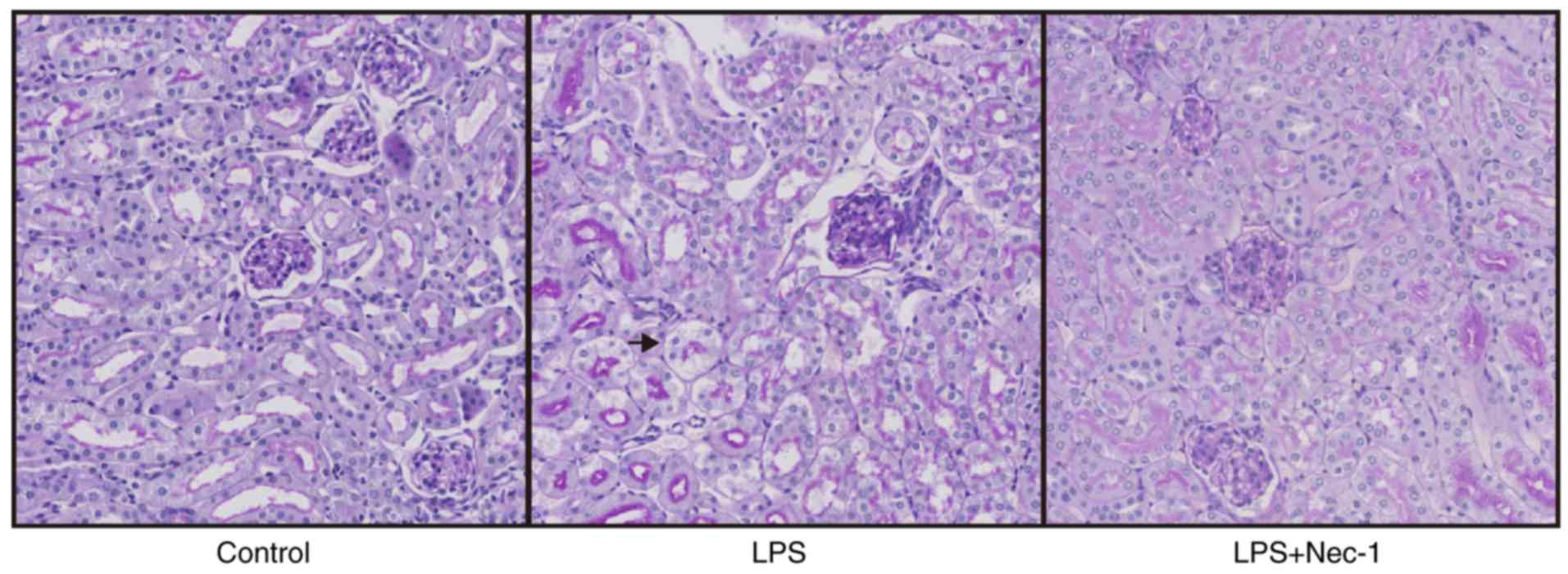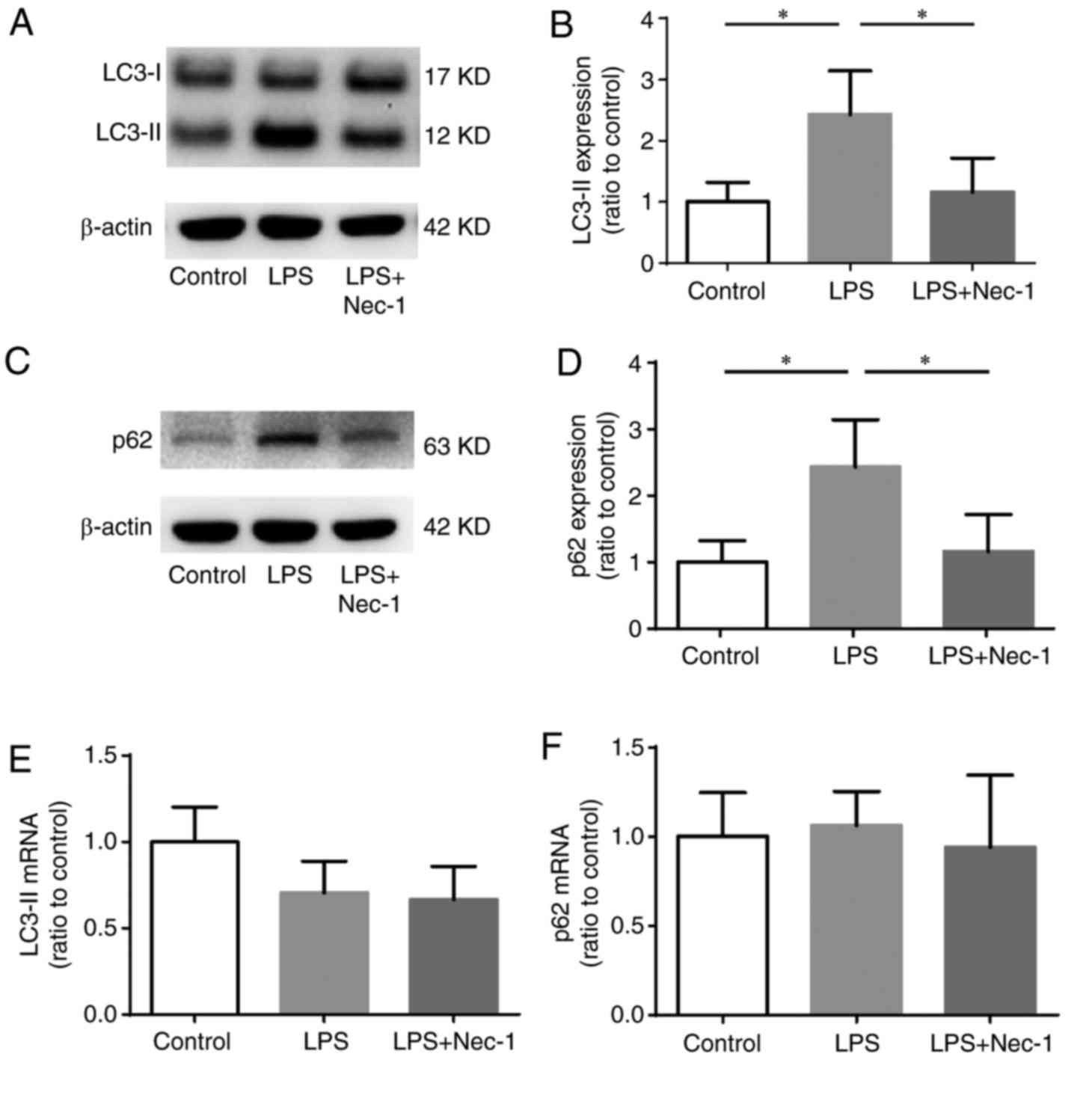|
1
|
Bellomo R, Kellum JA and Ronco C: Acute
kidney injury. Lancet. 380:756–766. 2012. View Article : Google Scholar : PubMed/NCBI
|
|
2
|
Yang L, Xing G, Wang L, Wu Y, Li S, Xu G,
He Q, Chen J, Chen M, Liu X, et al: Acute kidney injury in China: A
cross-sectional survey. Lancet. 386:1465–1471. 2015. View Article : Google Scholar : PubMed/NCBI
|
|
3
|
Xu X, Nie S, Liu Z, Chen C, Xu G, Zha Y,
Qian J, Liu B, Han S, Xu A, et al: Epidemiology and clinical
correlates of AKI in Chinese Hospitalized adults. Clin J Am Soc
Nephro. 10:1510–1518. 2015. View Article : Google Scholar
|
|
4
|
Zhou J, Qian C, Zhao M, Yu X, Kang Y, Ma
X, Ai Y, Xu Y, Liu D, An Y, et al: Epidemiology and outcome of
severe sepsis and septic shock in intensive care units in mainland
China. PLoS One. 9:e1071812014. View Article : Google Scholar : PubMed/NCBI
|
|
5
|
Chertow GM, Burdick E, Honour M, Bonventre
JV and Bates DW: Acute kidney injury, mortality, length of stay,
and costs in hospitalized patients. J Am Soc Nephrol. 16:3365–3370.
2005. View Article : Google Scholar : PubMed/NCBI
|
|
6
|
Bagshaw SM, George C and Bellomo R; ANZICS
Database Management Committee, : Early acute kidney injury and
sepsis: A multicentre evaluation. Crit Care. 12:R472008. View Article : Google Scholar : PubMed/NCBI
|
|
7
|
Thomas M, Sitch A and Dowswell G: The
initial development and assessment of an automatic alert warning of
acute kidney injury. Nephrol Dial Transplant. 26:2161–2168. 2011.
View Article : Google Scholar : PubMed/NCBI
|
|
8
|
Perner A, Haase N, Guttormsen AB, Tenhunen
J, Klemenzson G, Åneman A, Madsen KR, Møller MH, Elkjær JM, Poulsen
LM, et al: Hydroxyethyl starch 130/0.42 versus Ringer's acetate in
severe sepsis. N Engl J Med. 367:124–134. 2012. View Article : Google Scholar : PubMed/NCBI
|
|
9
|
Kellum JA, Chawla LS, Keener C, Singbartl
K, Palevsky PM, Pike FL, Yealy DM, Huang DT and Angus DC; ProCESS
and ProGReSS-AKI Investigators, : The effects of alternative
resuscitation strategies on acute kidney injury in patients with
septic shock. Am J Respir Crit Care Med. 193:281–287. 2016.
View Article : Google Scholar : PubMed/NCBI
|
|
10
|
Linkermann A, Brasen JH, Himmerkus N, Liu
S, Huber TB, Kunzendorf U and Krautwald S: Rip1
(receptor-interacting protein kinase 1) mediates necroptosis and
contributes to renal ischemia/reperfusion injury. Kidney Int.
81:751–761. 2012. View Article : Google Scholar : PubMed/NCBI
|
|
11
|
Xu Y, Ma H, Shao J, Wu J, Zhou L, Zhang Z,
Wang Y, Huang Z, Ren J, Liu S, et al: A role for tubular
necroptosis in cisplatin-induced AKI. J Am Soc Nephrol.
26:2647–2658. 2015. View Article : Google Scholar : PubMed/NCBI
|
|
12
|
Linkermann A, Heller JO, Prókai A,
Weinberg JM, De Zen F, Himmerkus N, Szabó AJ, Bräsen JH, Kunzendorf
U and Krautwald S: The RIP1-kinase inhibitor necrostatin-1 prevents
osmotic nephrosis and contrast-induced AKI in mice. J Am Soc
Nephrol. 24:1545–1557. 2013. View Article : Google Scholar : PubMed/NCBI
|
|
13
|
Takasu O, Gaut JP, Watanabe E, To K,
Fagley RE, Sato B, Jarman S, Efimov IR, Janks DL, Srivastava A, et
al: Mechanisms of cardiac and renal dysfunction in patients dying
of sepsis. Am J Resp Crit Care Med. 187:509–517. 2013. View Article : Google Scholar : PubMed/NCBI
|
|
14
|
Green DR and Levine B: To be or not to be?
How selective autophagy and cell death govern cell fate. Cell.
157:65–75. 2014. View Article : Google Scholar : PubMed/NCBI
|
|
15
|
Kimura A, Ishida Y, Inagaki M, Nakamura Y,
Sanke T, Mukaida N and Kondo T: Interferon-γ is protective in
cisplatin-induced renal injury by enhancing autophagic flux. Kidney
Int. 82:1093–1104. 2012. View Article : Google Scholar : PubMed/NCBI
|
|
16
|
Howell GM, Gomez H, Collage RD, Loughran
P, Zhang X, Escobar DA, Billiar TR, Zuckerbraun BS and Rosengart
MR: Augmenting autophagy to treat acute kidney injury during
endotoxemia in mice. PLoS One. 8:e695202013. View Article : Google Scholar : PubMed/NCBI
|
|
17
|
Wang LT, Chen BL, Wu CT, Huang KH, Chiang
CK and Hwa LS: Protective role of AMP-activated protein
kinase-evoked autophagy on an in vitro model of
ischemia/reperfusion-induced renal tubular cell injury. PLoS One.
8:e798142013. View Article : Google Scholar : PubMed/NCBI
|
|
18
|
Liang X, Chen Y, Zhang L, Jiang F, Wang W,
Ye Z, Liu S, Yu C and Shi W: Necroptosis, a novel form of
caspase-independent cell death, contributes to renal epithelial
cell damage in an ATP-depleted renal ischemia model. Mol Med Rep.
10:719–724. 2014. View Article : Google Scholar : PubMed/NCBI
|
|
19
|
Livak KJ and Schmittgen TD: Analysis of
relative gene expression data using real-time quantitative PCR and
the 2(-Delta Delta C(T)) method. Methods. 25:402–408. 2001.
View Article : Google Scholar : PubMed/NCBI
|
|
20
|
Berg TO, Fengsrud M, Stromhaug PE, Berg T
and Seglen PO: Isolation and characterization of rat liver
amphisomes. Evidence for fusion of autophagosomes with both early
and late endosomes. J Biol Chem. 273:21883–21892. 1998. View Article : Google Scholar : PubMed/NCBI
|
|
21
|
Degterev A, Hitomi J, Germscheid M, Ch'en
IL, Korkina O, Teng X, Abbott D, Cuny GD, Yuan C, Wagner G, et al:
Identification of RIP1 kinase as a specific cellular target of
necrostatins. Nat Chem Biol. 4:313–321. 2008. View Article : Google Scholar : PubMed/NCBI
|
|
22
|
He S, Wang L, Miao L, Wang T, Du F, Zhao L
and Wang X: Receptor interacting protein kinase-3 determines
cellular necrotic response to TNF-alpha. Cell. 137:1100–1111. 2009.
View Article : Google Scholar : PubMed/NCBI
|
|
23
|
Degterev A, Huang Z, Boyce M, Li Y, Jagtap
P, Mizushima N, Cuny GD, Mitchison TJ, Moskowitz MA and Yuan J:
Chemical inhibitor of nonapoptotic cell death with therapeutic
potential for ischemic brain injury. Nat Chem Biol. 1:112–119.
2005. View Article : Google Scholar : PubMed/NCBI
|
|
24
|
Takahashi K, Mizukami H, Kamata K, Inaba
W, Kato N, Hibi C and Yagihashi S: Amelioration of acute kidney
injury in lipopolysaccharide-induced systemic inflammatory response
syndrome by an aldose reductase inhibitor, fidarestat. PLoS One.
7:e301342012. View Article : Google Scholar : PubMed/NCBI
|
|
25
|
Guo R, Wang Y, Minto AW, Quigg RJ and
Cunningham PN: Acute renal failure in endotoxemia is dependent on
caspase activation. J Am Soc Nephrol. 15:3093–3102. 2004.
View Article : Google Scholar : PubMed/NCBI
|
|
26
|
Langenberg C, Gobe G, Hood S, May CN and
Bellomo R: Renal histopathology during experimental septic acute
kidney injury and recovery. Crit Care Med. 42:e58–e67. 2014.
View Article : Google Scholar : PubMed/NCBI
|
|
27
|
Tran M, Tam D, Bardia A, Bhasin M, Rowe
GC, Kher A, Zsengeller ZK, Akhavan-Sharif MR, Khankin EV,
Saintgeniez M, et al: PGC-1α promotes recovery after acute kidney
injury during systemic inflammation in mice. J Clin Invest.
121:4003–4014. 2011. View
Article : Google Scholar : PubMed/NCBI
|
|
28
|
Luo J, Tao Y, Liang X, Chen Y, Zhang L,
Jiang F, Liu S, Ye Z, Li Z and Shi W: Flow control effect of
necrostatin-1 on cell death of the NRK-52E renal tubular epithelial
cell line. Mol Med Rep. 16:57–62. 2017. View Article : Google Scholar : PubMed/NCBI
|
|
29
|
Liu ZG, Hsu H, Goeddel DV and Karin M:
Dissection of TNF receptor 1 effector functions: JNK activation is
not linked to apoptosis while NF-kappaB activation prevents cell
death. Cell. 87:565–576. 1996. View Article : Google Scholar : PubMed/NCBI
|
|
30
|
Moriwaki K, Bertin J, Gough PJ and Chan
FK: A RIPK3-caspase 8 complex mediates atypical pro-IL-1β
processing. J Immunol. 194:1938–1944. 2015. View Article : Google Scholar : PubMed/NCBI
|
|
31
|
Kimura T, Takabatake Y, Takahashi A,
Kaimori JY, Matsui I, Namba T, Kitamura H, Niimura F, Matsusaka T,
Soga T, et al: Autophagy protects the proximal tubule from
degeneration and acute ischemic injury. J Am Soc Nephrol.
22:902–913. 2011. View Article : Google Scholar : PubMed/NCBI
|
|
32
|
Hsiao HW, Tsai KL, Wang LF, Chen YH,
Chiang PC, Chuang SM and Hsu C: The decline of autophagy
contributes to proximal tubular dysfunction during sepsis. Shock.
37:289–296. 2012. View Article : Google Scholar : PubMed/NCBI
|
|
33
|
Takahashi A, Kimura T, Takabatake Y, Namba
T, Kaimori J, Kitamura H, Matsui I, Niimura F, Matsusaka T, Fujita
N, et al: Autophagy guards against cisplatin-induced acute kidney
injury. Am J Pathol. 180:517–525. 2012. View Article : Google Scholar : PubMed/NCBI
|
|
34
|
Yonekawa T, Gamez G, Kim J, Tan AC,
Thorburn J, Gump J, Thorburn A and Morgan MJ: RIP1 negatively
regulates basal autophagic flux through TFEB to control sensitivity
to apoptosis. EMBO Rep. 16:700–708. 2015. View Article : Google Scholar : PubMed/NCBI
|














